Sustainability Analysis and Scenarios in Groundwater Pumping Systems: A Case Study for Tenerife Island to 2030
Abstract
:1. Introduction
2. Groundwater and Energy Review in Tenerife
2.1. Water Resource Information
2.1.1. Groundwater Wells
2.1.2. Location of the Wells
2.2. Groundwater Demand
2.3. Energy Supply
3. Methodology and Preliminary Analysis
- Data: obtaining data and characteristics of the Tenerife Island in terms of water and energy (Section 2).
- Methodology review: reviewing PV pump design methodologies based on different studies and the projection of future water resources.
- Current scenario in Tenerife: implementing the methodology that allows modeling of a hypothetical scenario in which all wells are powered 100% by PV, and a study of the surface area required for the PV installations.
- Economic study: evaluating the economic performance of a PV pumping system.
- Tenerife 2030 scenario: an approximation of the future water scenario reaching the Sustainable Development Goals for 2030.
3.1. PV Capacity
3.1.1. Pumping Energy
3.1.2. PV Capacity (P)
3.2. LCOE
- The PV plant only has an initial investment cost in the first year, t = 1. The cost is proportional to the peak power and was set to 1000 €/kWp.
- Battery initial investment (Surette 4KS25P/6CS25P): 50 €/unit, where the battery is used to store energy when there is no solar resource available. Battery lifetime: 8 years.
- Hybrid inverter initial investment: 150 €/kW.
- The lifetime of the whole system was set in 25 years for the solar panels, 15 years for the inverter, 8 years for the battery, and 20 years for the pump and hydraulic system.
- The annual energy production is according to the daily flow rate.
- Discount rate.
- Annual maintenance costs were considered to be 4.5% of the initial cost, an annual investment.
- Annual maintenance costs were considered as 5 €/year.
- Inverter efficiency of 97% for all sizes was considered.
- The primary load was considered to be between 9:00 and 15:00, the usual irrigation time.
3.3. Water Resource Projection to 2030
4. Results and Discussion
4.1. PV Pumping for the Actual Scenario
4.2. Required Surface Area
4.3. LCOE Analysis
4.4. 2030 Trend Scenario
5. Conclusions
Author Contributions
Funding
Conflicts of Interest
References
- United Nations Population. Available online: https://www.un.org/en/global-issues/population (accessed on 12 March 2022).
- Pimentel, D.; Burgess, M. World Human Population Problems. In Encyclopedia of the Anthropocene; Dellasala, D.A., Goldstein, M.I., Eds.; Elsevier: Oxford, UK, 2018; pp. 313–317. ISBN 978-0-12-813576-1. [Google Scholar]
- Food and Agriculture Organization (FAO). El Estado de La Seguridad Alimentaria y La Nutrición en el Mundo 2019; FAO: Rome, Italy, 2019; ISBN 978-92-5-131600-9. [Google Scholar]
- UN-Water. Water for a Sustainable World (2022 Report). Available online: https://www.unwater.org/publications/un-world-water-development-report-2022 (accessed on 15 July 2022).
- WRI. Mexico Una Cuarta Parte de La Población Mundial Padece Escasez de Agua|WRI Mexico. Available online: https://wrimexico.org/bloga/una-cuarta-parte-de-la-poblaci%C3%83%C2%B3n-mundial-padece-escasez-de-agua#:~:text=Datos-arrojados-por-las-herramientas,en-promedio-cada-a%C3%83%C2%B1o%2Cm%C3%83%C2%A1s (accessed on 12 March 2022).
- Instituto de Recursos Mundiales. 17 Países, Hogar de Una Cuarta Parte de La Población Mundial, Enfrentan un Estrés Hídrico Extremadamente Alto. Available online: https://listindiario.com/la-vida/2022/03/22/714000/unos-17-paises-enfrentan-un-estres-hidrico-extremo-segun-estudio (accessed on 30 March 2022).
- WRI. Ranking the World’s Most Water-Stressed Countries in 2040|World Resources Institute. Available online: https://www.wri.org/insights/ranking-worlds-most-water-stressed-countries-2040 (accessed on 9 May 2022).
- WWAP. Informe Mundial de Las Naciones Unidas Sobre el Desarrollo de Los Recursos Hídricos 2019. No Dejar a Nadie Atrás. Available online: http://www.unwater.org/publications/world-water-development-report-2019/ (accessed on 20 April 2020).
- Jasechko, S.; Perrone, D. Global Groundwater Wells at Risk of Running Dry. Science 2021, 1979, 418–421. [Google Scholar] [CrossRef] [PubMed]
- Custodio, E.; del Carmen Cabrera, M.; Poncela, R.; Puga, L.-O.; Skupien, E.; del Villar, A. Groundwater Intensive Exploitation and Mining in Gran Canaria and Tenerife, Canary Islands, Spain: Hydrogeological, Environmental, Economic and Social Aspects. Sci. Total Environ. 2016, 557–558, 425–437. [Google Scholar] [CrossRef] [PubMed]
- Pétré, M.A.; Rivera, A.; Lefebvre, R. Numerical Modeling of a Regional Groundwater Flow System to Assess Groundwater Storage Loss, Capture and Sustainable Exploitation of the Transboundary Milk River Aquifer (Canada—USA). J. Hydrol. 2019, 575, 656–670. [Google Scholar] [CrossRef]
- Jasechko, S.; Perrone, D.; Seybold, H.; Fan, Y.; Kirchner, J.W. Groundwater Level Observations in 250,000 Coastal US Wells Reveal Scope of Potential Seawater Intrusion. Nat. Commun. 2020, 11, 3229. [Google Scholar] [CrossRef] [PubMed]
- Joaquín Melgarejo and Patricia Fernández-Aracil Congreso Nacional Del Agua Orihuela. Innovación y Sostenibilidad. In Proceedings of the Congreso Nacional del Agua Orihuela. Innovación y Sostenibilidad; Universitat d’Alacant: Alicante, Spain, 2019. [Google Scholar]
- Greenpeace La Incertidumbre Sobre el Robo del Agua: ¡Fíltrala! Available online: https://es.greenpeace.org/es/sala-de-prensa/documentos/la-incertidumbre-sobre-el-robo-del-agua-filtrala/ (accessed on 9 May 2022).
- Antony, S.; Dev, V.V.; Kaliraj, S.; Ambili, M.S.; Krishnan, K.A. Seasonal Variability of Groundwater Quality in Coastal Aquifers of Kavaratti Island, Lakshadweep Archipelago, India. Groundw. Sustain. Dev. 2020, 11, 100377. [Google Scholar] [CrossRef]
- Banks, E.W.; Post, V.E.A.; Meredith, K.; Ellis, J.; Cahill, K.; Noorduijn, S.; Batelaan, O. Fresh Groundwater Lens Dynamics of a Small Bedrock Island in the Tropics, Northern Australia. J. Hydrol. 2021, 595, 125942. [Google Scholar] [CrossRef]
- Werner, A.D.; Sharp, H.K.; Galvis, S.C.; Post, V.E.A.; Sinclair, P. Hydrogeology and management of freshwater lenses on atoll islands: Review of current knowledge and research needs. J. Hydrol. 2017, 551, 819–844. [Google Scholar] [CrossRef]
- Haffaf, A.; Lakdja, F.; Meziane, R.; Abdeslam, D.O. Study of Economic and Sustainable Energy Supply for Water Irrigation System (WIS). Sustain. Energy Grids Netw. 2021, 25, 100412. [Google Scholar] [CrossRef]
- Rubio-Aliaga, A.; García-Cascales, M.S.; Sánchez-Lozano, J.M.; Molina-Garcia, A. MCDM-Based Multidimensional Approach for Selection of Optimal Groundwater Pumping Systems: Design and Case Example. Renew. Energy 2021, 163, 213–224. [Google Scholar] [CrossRef]
- Aliyu, M.; Hassan, G.; Said, S.A.; Siddiqui, M.U.; Alawami, A.T.; Elamin, I.M. A Review of Solar-Powered Water Pumping Systems. Renew. Sustain. Energy Rev. 2018, 87, 61–76. [Google Scholar] [CrossRef]
- Muhsen, D.H.; Ghazali, A.B.; Khatib, T.; Abdulabbas, T.E. Techno-Economic Study and Optimal Sizing of a Stand-Alone Photovoltaic Water Pumping System. Int. Trans. Electr. Energy Syst. 2017, 27, e2355. [Google Scholar] [CrossRef]
- Ebaid, M.S.Y.; Qandil, H.; Hammad, M. A Unified Approach for Designing a Photovoltaic Solar System for the Underground Water Pumping Well-34 at Disi Aquifer. Energy Convers. Manag. 2013, 75, 780–795. [Google Scholar] [CrossRef]
- Khatib, T. Tamer Khatib Design of PV Water Pumping System at Minimum Cost for Palestine: A Review. J. Appl. Sci. 2010, 22, 2773–2784. [Google Scholar] [CrossRef] [Green Version]
- WRI. Domestic Water Use Grew 600% Over the Past 50 Years|World Resources Institute. Available online: https://www.wri.org/blog/2020/02/growth-domestic-water-use (accessed on 14 March 2021).
- Shi, F.; Zhao, C.; Zhao, X.; Zhou, X.; Li, X.; Zhu, J. Spatial Variability of the Groundwater Exploitation Potential in an Arid Alluvial-Diluvial Plain Using GIS-Based Dempster-Shafer Theory. Quat. Int. 2020, 571, 127–135. [Google Scholar] [CrossRef]
- Mostefaoui, Z.; Amara, S. Renewable Energy Analysis in the Agriculture–Greenhouse Farms: A Case Study in the Mediterranean Region (Sidi Bel Abbes, Algeria). Environ. Prog. Sustain. Energy 2019, 38, e13029. [Google Scholar] [CrossRef]
- Rubio-Aliaga, Á.; García-Cascales, M.S.; Sánchez-Lozano, J.M.; Molina-García, A. Multidimensional Analysis of Groundwater Pumping for Irrigation Purposes: Economic, Energy and Environmental Characterization for PV Power Plant Integration. Renew. Energy 2019, 138, 174–186. [Google Scholar] [CrossRef]
- Sarkar, M.N.I.; Ghosh, H.R. Techno-Economic Analysis and Challenges of Solar Powered Pumps Dissemination in Bangladesh. Sustain. Energy Technol. Assess. 2017, 20, 33–46. [Google Scholar] [CrossRef]
- Singh, D.B.; Mahajan, A.; Devli, D.; Bharti, K.; Kandari, S.; Mittal, G. A Mini Review on Solar Energy Based Pumping System for Irrigation. Mater. Today Proc. 2021, 43, 417–425. [Google Scholar] [CrossRef]
- Al-Smairan, M. Application of photovoltaic array for pumping water as an alternative to diesel engines in Jordan Badia, Tall Hassan station: Case study. Renew. Sustain. Energy Rev. 2012, 16, 4500–4507. [Google Scholar] [CrossRef]
- Jadhav, P.J.; Sawant, N.; Panicker, A.M. Technical Paradigms in Electricity Supply for Irrigation Pumps: Case of Maharashtra, India. Energy Sustain. Dev. 2020, 58, 50–62. [Google Scholar] [CrossRef]
- Verma, S.; Mishra, S.; Chowdhury, S.; Gaur, A.; Mohapatra, S.; Soni, A.; Verma, P. Solar PV Powered Water Pumping System—A Review. Mater. Today Proc. 2020, 46, 5601–5606. [Google Scholar] [CrossRef]
- Gupta, E. The Impact of Solar Water Pumps on Energy-Water-Food Nexus: Evidence from Rajasthan, India. Energy Policy 2019, 129, 598–609. [Google Scholar] [CrossRef]
- Insituto Canario de Estadística. Anuario Energético de Canarias. Available online: http://www.gobiernodecanarias.org/istac/jaxi-istac/menu.do?uripub=urn:uuid:131cf873-66a9-408d-8cfa-537d6be05067 (accessed on 1 June 2021).
- Life, T. 100% Tenerife Tourism—Tourism Research. Available online: https://www.webtenerife.com/investigacion/situacion-turistica/turismo-cifras/?page-index=4 (accessed on 9 June 2020).
- Santana, L.M.; Hern, R.E.Z.S.; Primavera, N.B. Precipitaciones Anuales Siglo XXI en Tenerife Segunda Parte. Available online: https://www.museosdetenerife.org/muna-museo-de-naturaleza-y-arqueologia/wp-content/uploads/sites/2/2021/01/LLUVIA-SIGLO-XXI-TENERIFE-SEGUNDA-PARTE-FINAL-MUNA-1-1.pdf (accessed on 9 May 2022).
- Consejo Insular de Aguas de Tenerife. Plan Hidrológico de Tenerife. Available online: https://www.aguastenerife.org/index.php?option=com_content&view=article&id=138&Itemid=1675 (accessed on 7 November 2021).
- Informe Rodeo de La Paja. Available online: https://www.tenerife.es/portalcabtfe/images/articulos/CEAT/Informe_Rodeo_de_la_Paja_web.report.pdf (accessed on 14 April 2021).
- Consejo Insular de Aguas de Tenerife. Obras de Captación de Aguas Subterráneas. Arcgis. Available online: https://www.arcgis.com/home/item.html?id=cda91956bd2541dca14236459219dcd6 (accessed on 9 September 2021).
- Domingoz Méndez, J. Agricultura en Tenerife: El Campo de Tenerife Ha Perdido Más de 7000 Hectáreas en Los Últimos Doce Años. Available online: https://www.eldia.es/tenerife/2021/05/02/campo-tinerfeno-perdido-7-000-50335757.html (accessed on 16 June 2021).
- CIATF. Análisis Económico y Recuperación de Costes Según Directiva Marco del Agua. Available online: https://www.aguastenerife.org/images/pdf/PHT1erCiclo/I-DocumentoInformacion/I-2-Anejos/I-2-Anejo2-DMAArt9-AnalisisEcRecuperacionCostes.pdf (accessed on 9 May 2022).
- Hernández, C.M. Recomendaciones de Riego en Tenerife. Available online: https://wapps001.uimp.es/uxxiconsultas/ficheros/5/22732Recomendaciones_de_riego_en_platanera_en_Tenerife.pdf (accessed on 9 May 2022).
- Ritter, A.; Machín, N. Nuevas Tecnologías Para Riego Sostenible en Platanera. Available online: https://www.icia.es/icia/download/suelosyriegos/Ritter_CanariasAgr_y_Pesq.pdf (accessed on 9 May 2022).
- Traxco. Análisis de Los Diferentes Sistemas de Riego del Plátano. Available online: https://www.traxco.es/blog/tecnologia-del-riego/riego-del-platano (accessed on 25 January 2022).
- Servicio_de_Planificación_Ordenación_Rural. Informe Estadistico. Mapa de Cultivos de Tenerife. Available online: https://www.gobiernodecanarias.org/agricultura/temas/mapa_cultivos/ (accessed on 9 May 2022).
- IDECanarias Visor 4.5.1. Available online: https://visor.grafcan.es/visorweb/ (accessed on 15 April 2021).
- Gumede, T.G.; Zau, A.T.P.; Malatji, M.J.; Daniel Chowdhury, S.P. Design of Stand-Alone Solar PV System to Pump Water to the Mtubatuba Village. In Proceedings of the IEEE AFRICON Conference 2019, Accra, Ghana, 25–27 September 2019. [Google Scholar] [CrossRef]
- UNEF. El Tiempo De La Energía Solar Fotovoltaica. Available online: www.unef.es (accessed on 31 March 2022).
- Cirés, E.; Marcos, J.; de la Parra, I.; García, M.; Marroyo, L. The Potential of Forecasting in Reducing the LCOE in PV Plants under Ramp-Rate Restrictions. Energy 2019, 188, 116053. [Google Scholar] [CrossRef]
- Closas, A.; Rap, E. Solar-Based Groundwater Pumping for Irrigation: Sustainability, Policies, and Limitations. Energy Policy 2017, 104, 33–37. [Google Scholar] [CrossRef]
- Pérez, J.C.; González, A.; Díaz, J.P.; Expósito, F.J.; Felipe, J. Climate Change Impact on Future Photovoltaic Resource Potential in an Orographically Complex Archipelago, the Canary Islands. Renew. Energy 2019, 133, 749–759. [Google Scholar] [CrossRef]
- Schallenberg-Rodríguez, J. Photovoltaic Techno-Economical Potential on Roofs in Regions and Islands: The Case of the Canary Islands. Methodological Review and Methodology Proposal. Renew. Sustain. Energy Rev. 2013, 20, 219–239. [Google Scholar] [CrossRef]
- Ramón Vozmediano, J. Cebrián Expansión y Características de Los «Huertos Solares»|Negocio Inmobiliario. Available online: https://negocioinmo.com/expansion-y-caracteristicas-de-los-huertos-solares/ (accessed on 28 June 2022).
- Sanchez-Lorenzo, A.; Calbó, J.; Wild, M. Global and Diffuse Solar Radiation in Spain: Building a Homogeneous Dataset and Assessing Their Trends. Glob. Planet. Chang. 2013, 100, 343–352. [Google Scholar] [CrossRef]
- Rodríguez-Urrego, D.; Cañadillas-Ramallo, D.; González-Díaz, B.; Guerrero-Lemus, R. Analysis of the Water-Energy Nexus Applied to an Insular System: Case Study of Tenerife. Sustainability 2022, 14, 1653. [Google Scholar] [CrossRef]
- Rosales-Asensio, E.; García-Moya, F.J.; González-Martínez, A.; Borge-Diez, D.; de Simón-Martín, M. Stress Mitigation of Conventional Water Resources in Water-Scarce Areas through the Use of Renewable Energy Powered Desalination Plants: An Application to the Canary Islands. Energy Rep. 2020, 6, 124–135. [Google Scholar] [CrossRef]
- Berna-Escriche, C.; Vargas-Salgado, C.; Alfonso-Solar, D.; Escrivá-Castells, A. Can a Fully Renewable System with Storage Cost-Effectively Cover the Total Demand of a Big Scale Standalone Grid? Analysis of Three Scenarios Applied to the Grand Canary Island, Spain by 2040. J. Energy Storage 2022, 52, 104774. [Google Scholar] [CrossRef]
- Cabrera, P.; Carta, J.A.; Lund, H.; Thellufsen, J.Z. Large-Scale Optimal Integration of Wind and Solar Photovoltaic Power in Water-Energy Systems on Islands. Energy Convers. Manag. 2021, 235, 113982. [Google Scholar] [CrossRef]
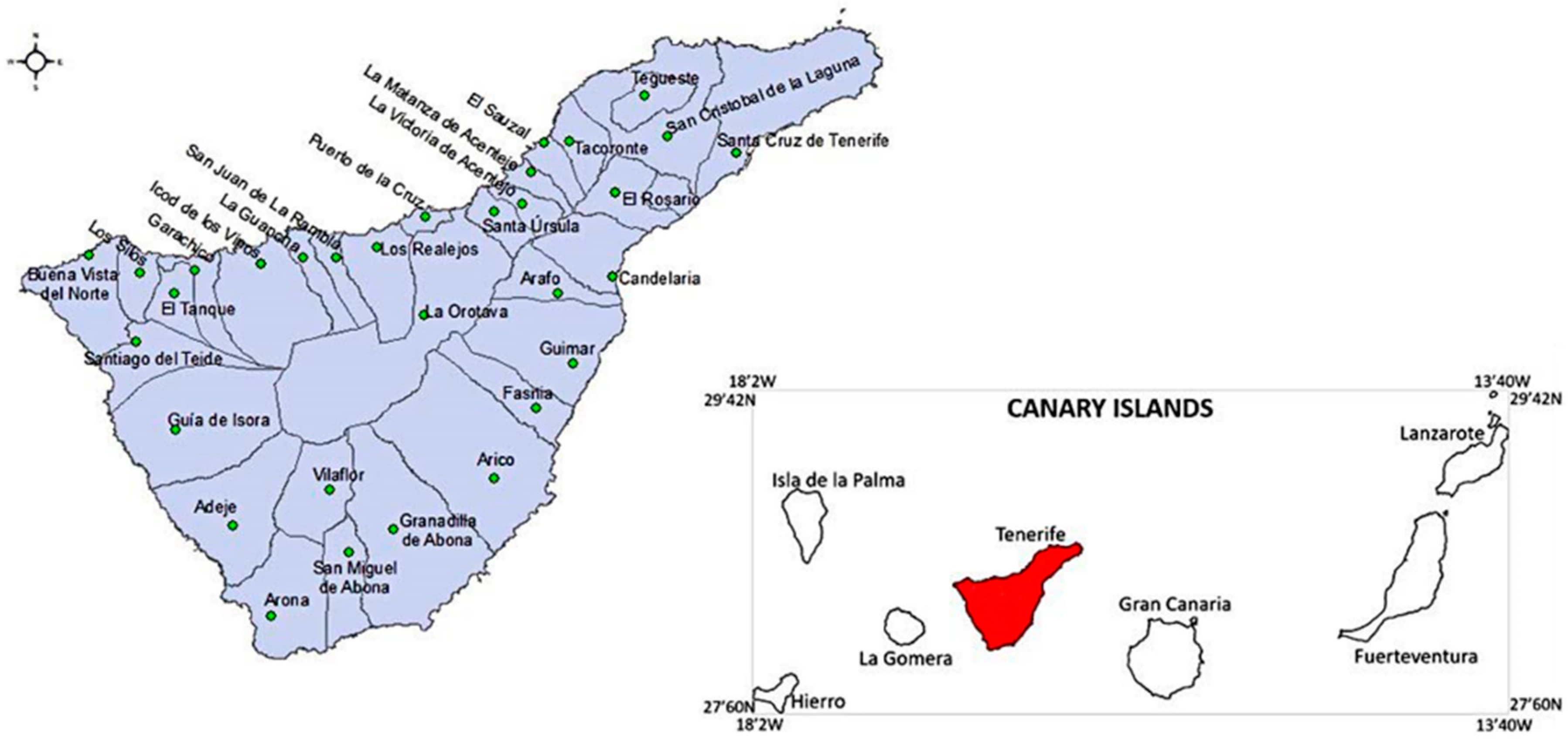
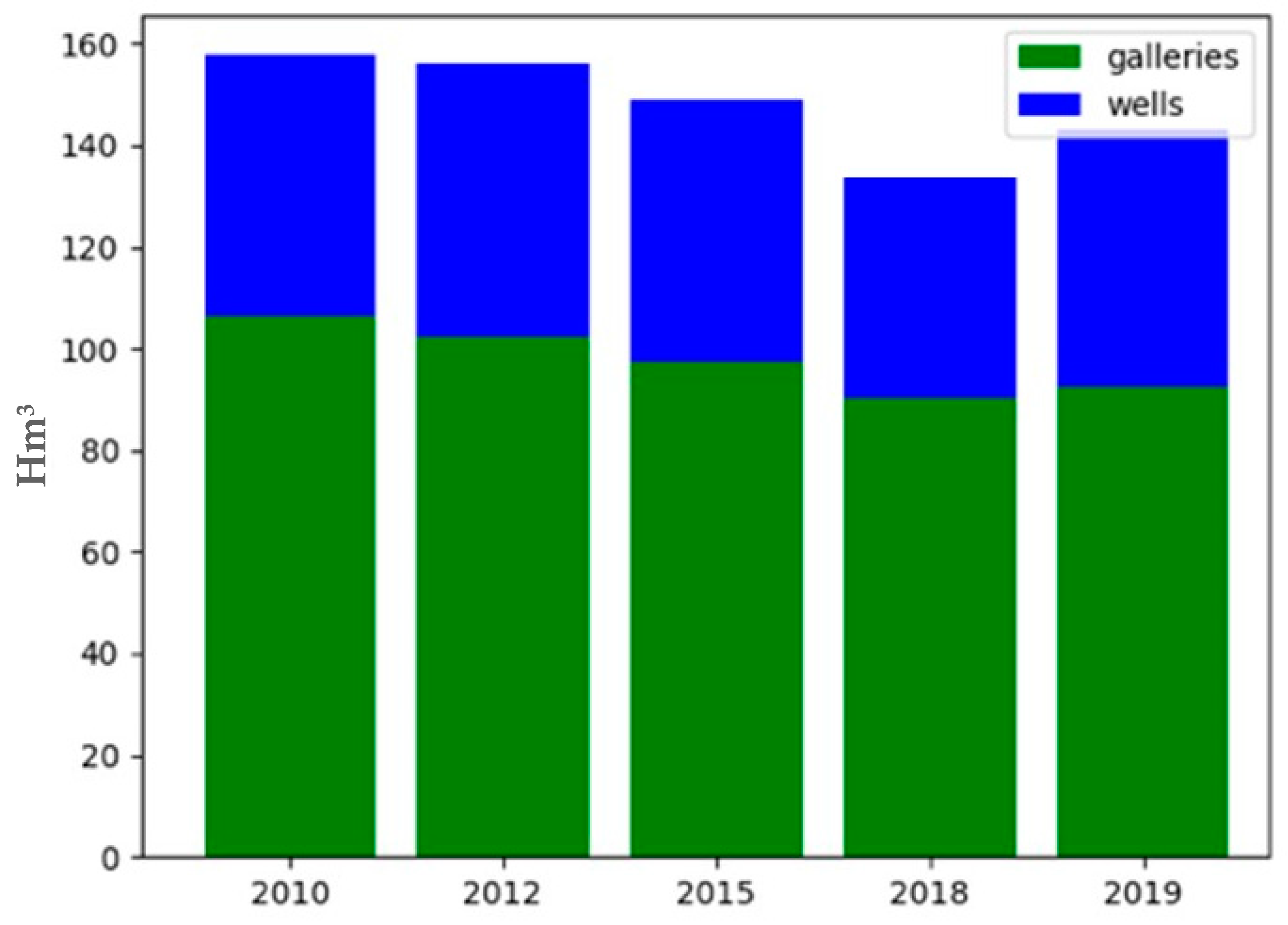
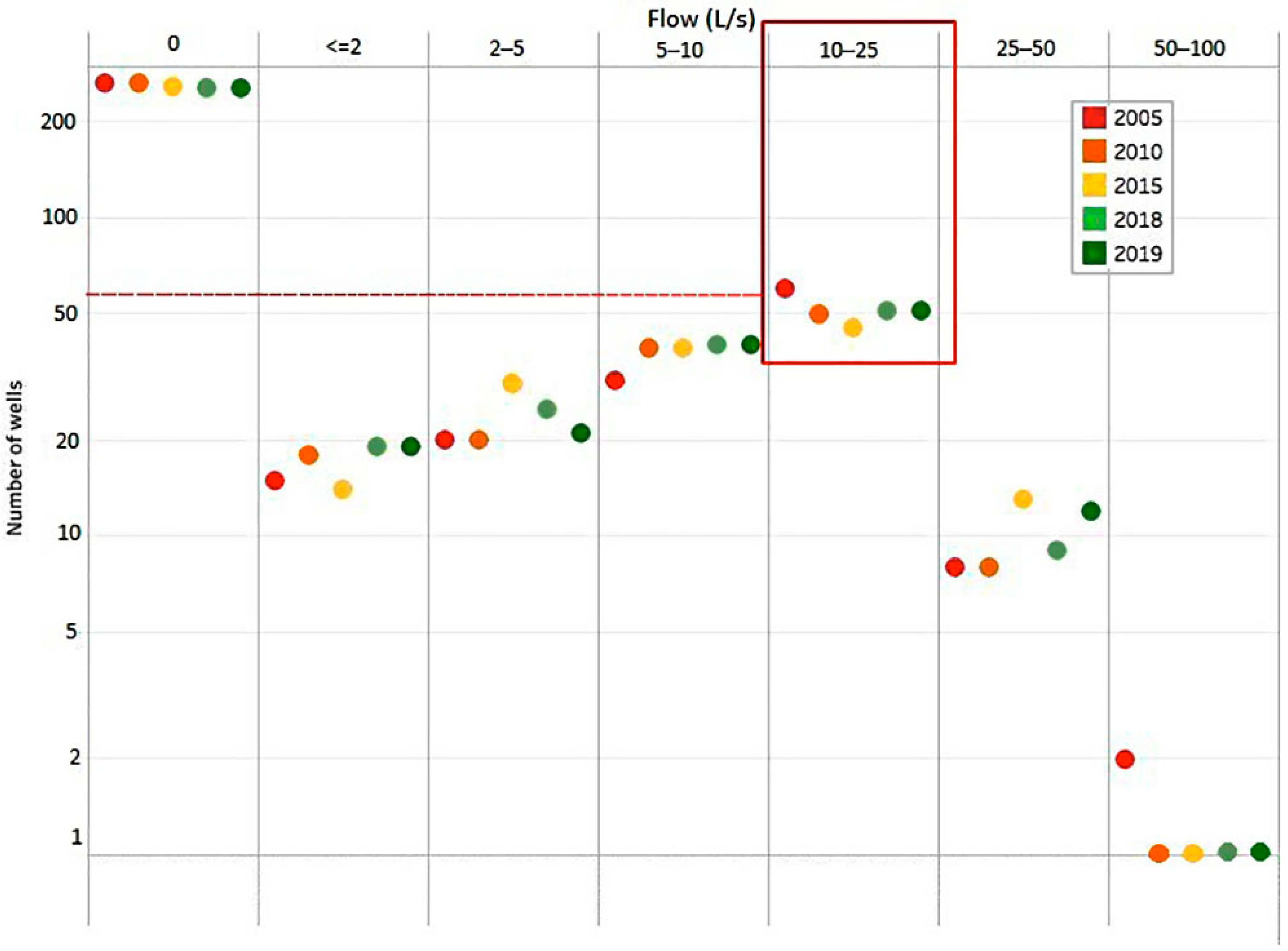
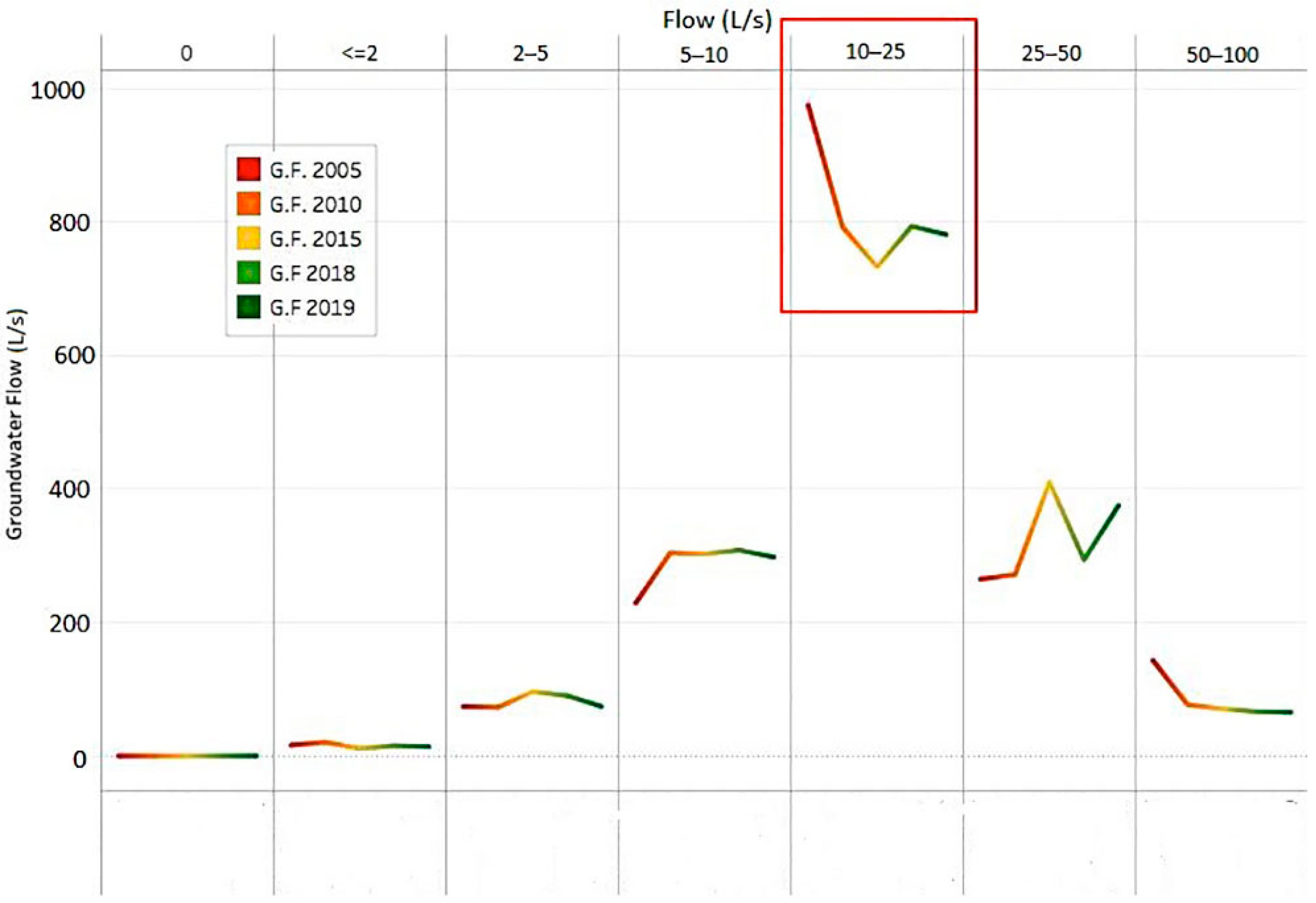
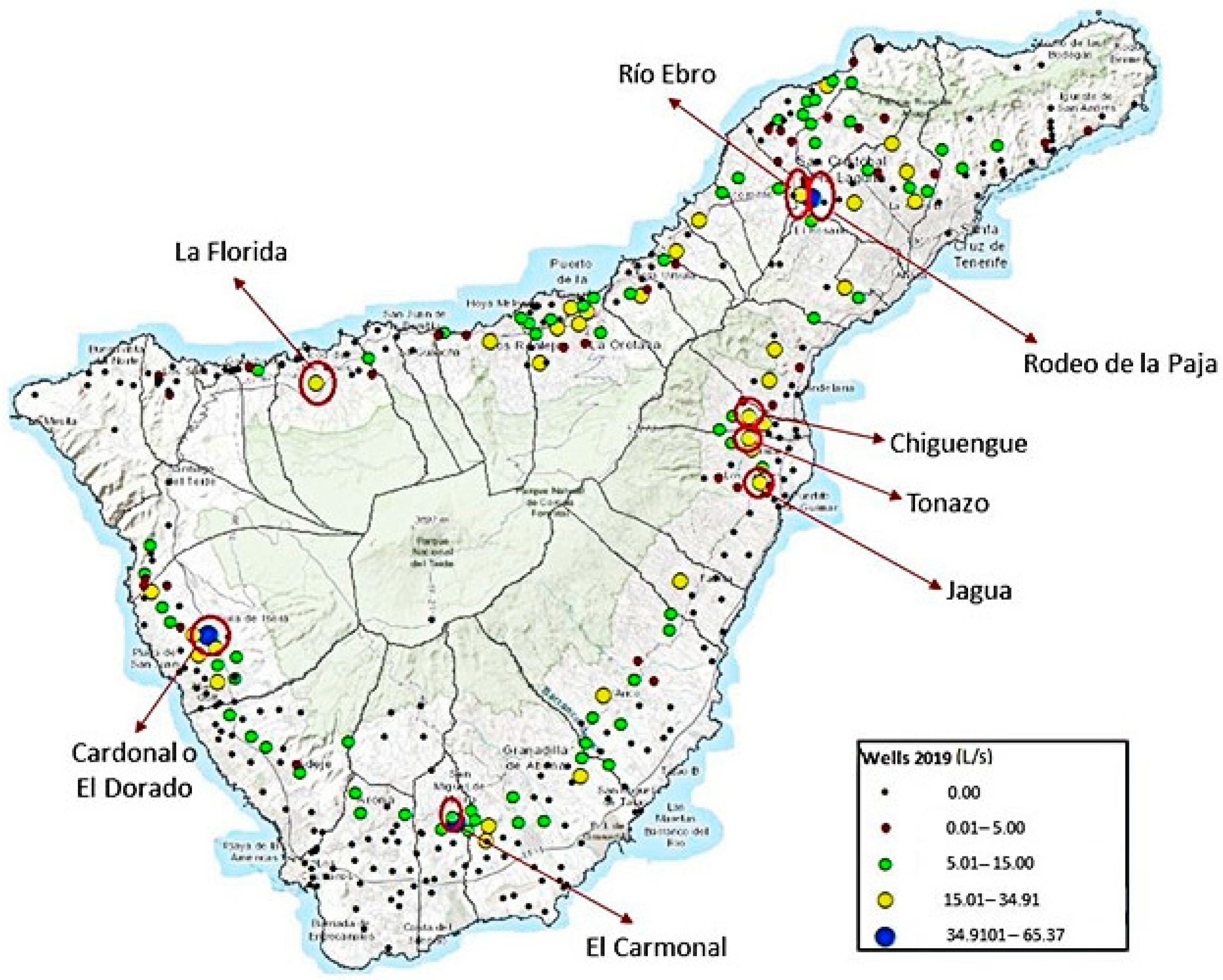
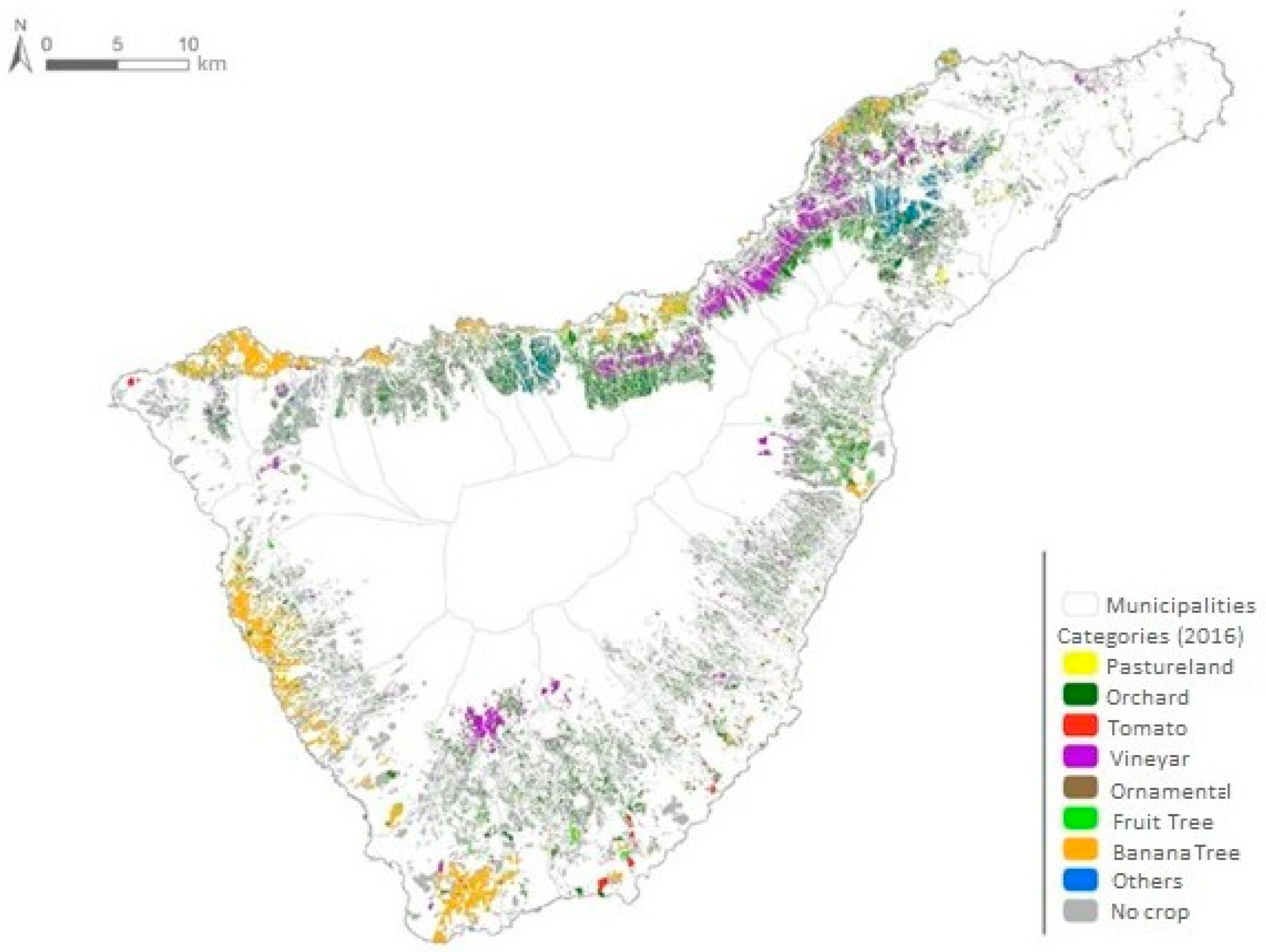
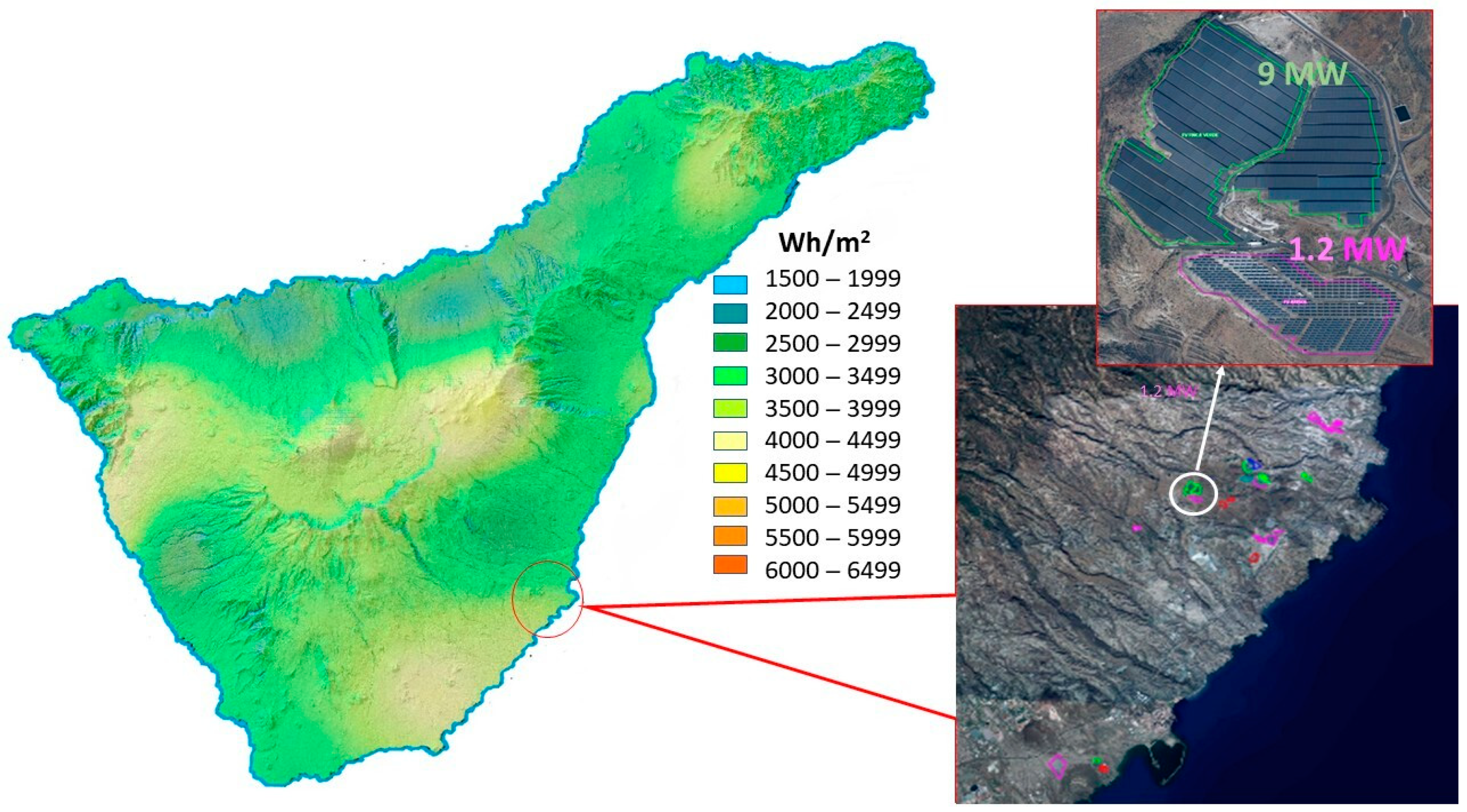

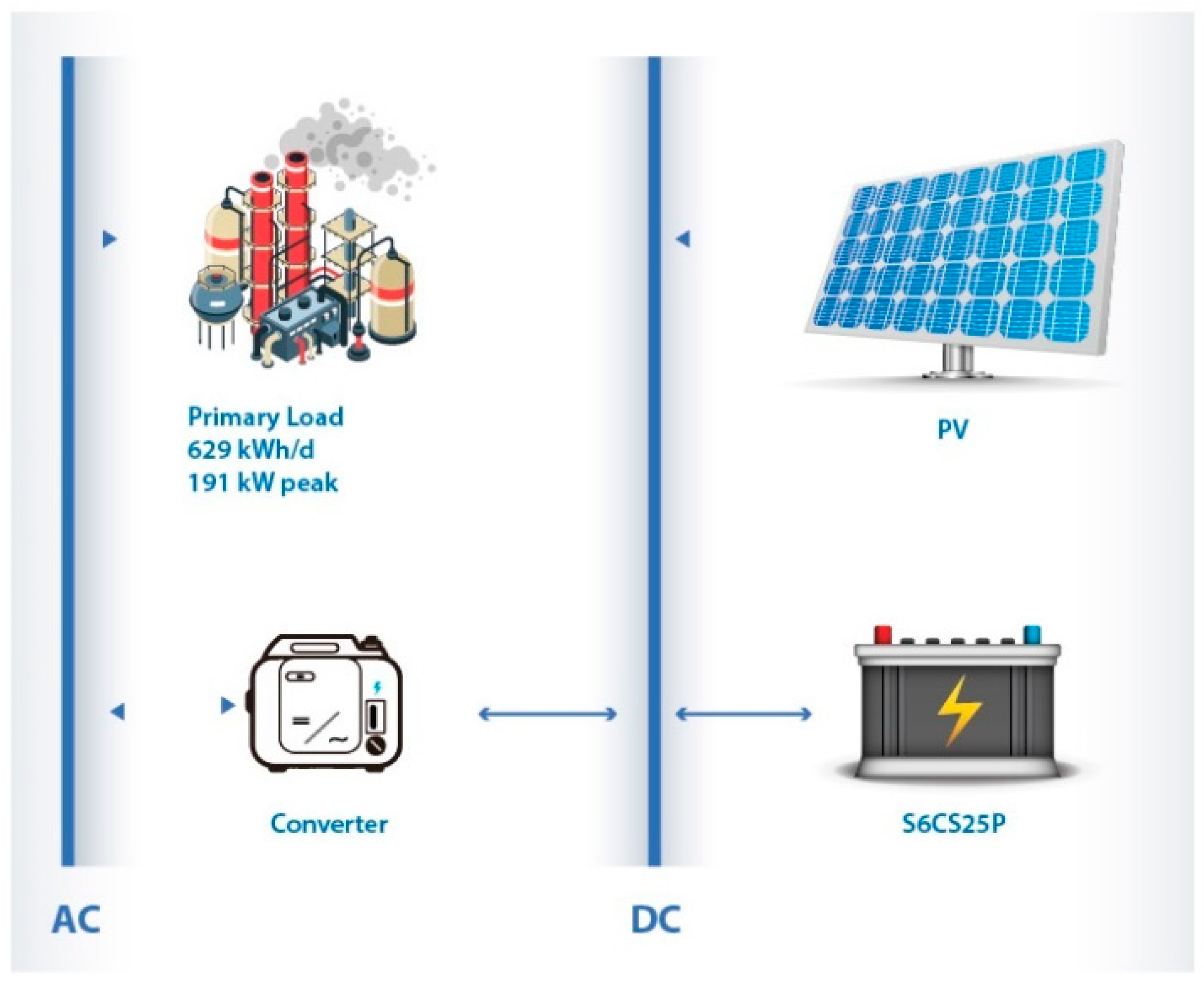
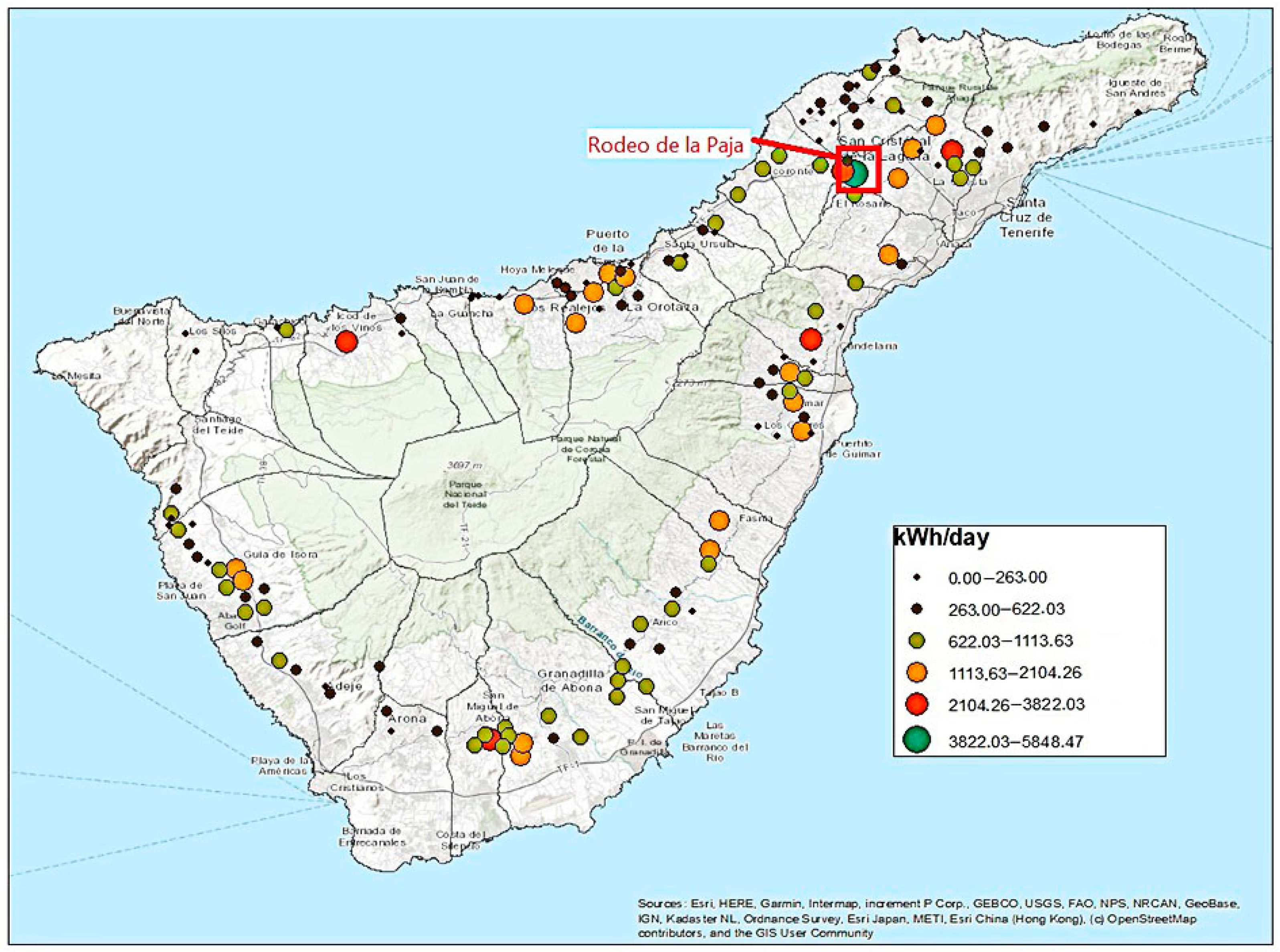




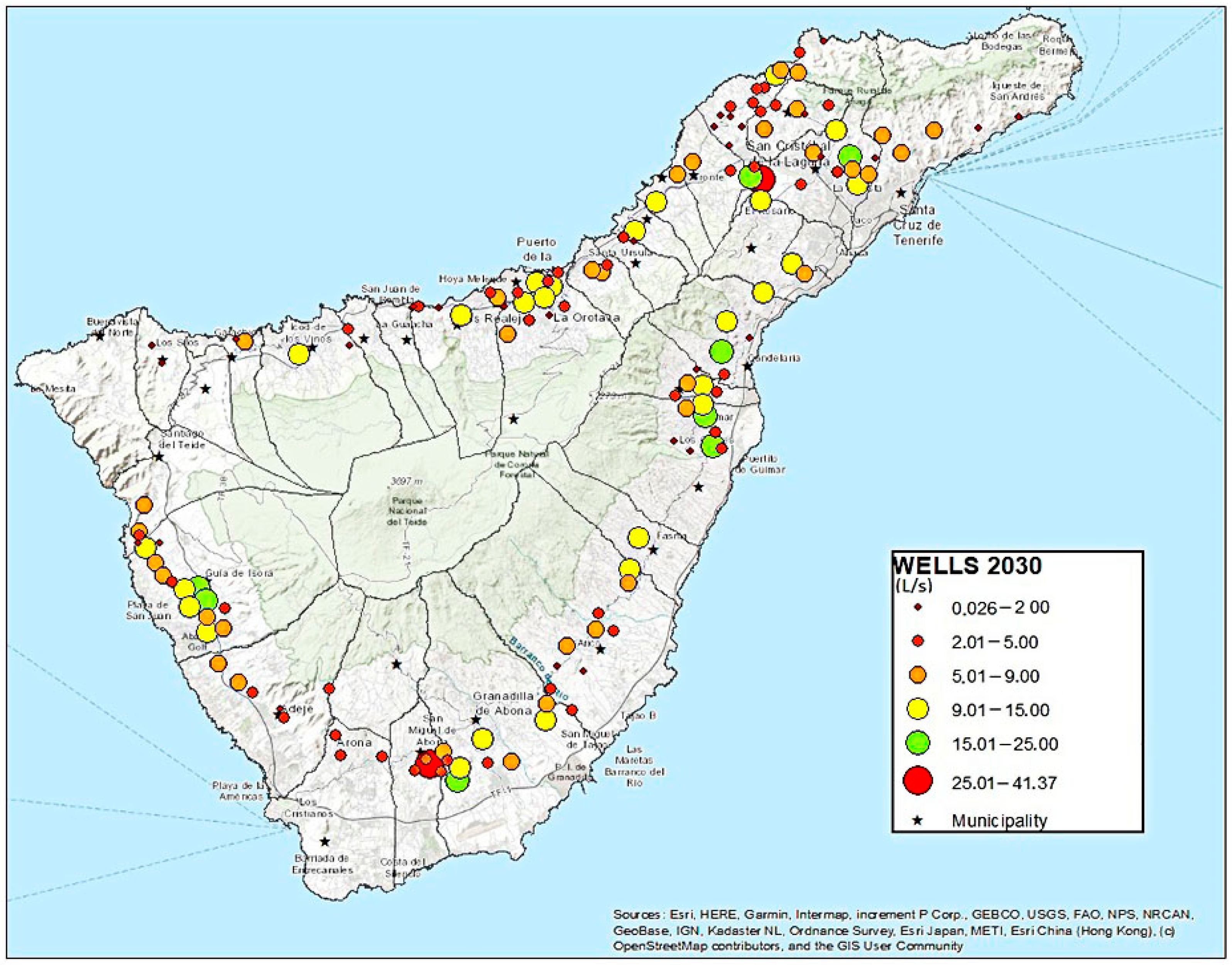
| Municipality | Galleries | Wells | Municipality | Galleries | Wells | ||||
|---|---|---|---|---|---|---|---|---|---|
| Number | Hm3 | Number | Hm3 | Number | Hm3 | Number | Hm3 | ||
| Adeje | 32 | 2.00 | 26 | 1.57 | Los Realejos | 168 | 9.81 | 6 | 0.87 |
| Arafo | 41 | 3.07 | 10 | 1.84 | El Rosario | 36 | 1.03 | 8 | 1.87 |
| Arico | 73 | 4.66 | 23 | 2.65 | El Tanque | 12 | 2.69 | 0 | 0.00 |
| Arona | 9 | 2.04 | 32 | 0.51 | Los Silos | 29 | 1.51 | 9 | 0.10 |
| Buenavista del Norte | 43 | 1.18 | 7 | 0.00 | La Victoria de Acentejo | 18 | 1.60 | 5 | 0.29 |
| Candelaria | 39 | 2.42 | 10 | 1.56 | Puerto de la Cruz | 1 | 0.87 | 13 | 1.90 |
| Fasnia | 20 | 2.98 | 6 | 0.74 | San Juan de la Rambla | 28 | 1.17 | 1 | 0.00 |
| Garachico | 25 | 2.37 | 9 | 0.44 | San Miguel | 1 | 0.06 | 14 | 1.87 |
| Granada de Abona | 37 | 0.61 | 36 | 4.05 | Santa Cruz de Tenerife | 52 | 1.33 | 30 | 0.99 |
| Guía de Isora | 50 | 9.81 | 27 | 6.47 | Santa Úrsula | 36 | 2.38 | 7 | 0.84 |
| Güímar | 40 | 3.69 | 23 | 3.55 | Santiago del Teide | 30 | 2.88 | 9 | 0.81 |
| Icod de los Vinos | 41 | 5.08 | 12 | 0.92 | Sauzal | 19 | 1.05 | 2 | 0.92 |
| La Guancha | 23 | 11.29 | 4 | 0.22 | Tacoronte | 24 | 0.64 | 3 | 0.63 |
| La Laguna | 40 | 0.90 | 43 | 9.87 | Tegueste | 19 | 0.08 | 7 | 1.21 |
| La Matanza de Acentejo | 12 | 1.48 | 3 | 0.49 | Vilaflor | 37 | 0.66 | 4 | 0.00 |
| La Orotava | 86 | 11.22 | 12 | 3.66 | |||||
Publisher’s Note: MDPI stays neutral with regard to jurisdictional claims in published maps and institutional affiliations. |
© 2022 by the authors. Licensee MDPI, Basel, Switzerland. This article is an open access article distributed under the terms and conditions of the Creative Commons Attribution (CC BY) license (https://creativecommons.org/licenses/by/4.0/).
Share and Cite
Rodríguez-Urrego, D.; Rodríguez-Urrego, L.; González-Díaz, B.; Guerrero-Lemus, R. Sustainability Analysis and Scenarios in Groundwater Pumping Systems: A Case Study for Tenerife Island to 2030. Energies 2022, 15, 5635. https://doi.org/10.3390/en15155635
Rodríguez-Urrego D, Rodríguez-Urrego L, González-Díaz B, Guerrero-Lemus R. Sustainability Analysis and Scenarios in Groundwater Pumping Systems: A Case Study for Tenerife Island to 2030. Energies. 2022; 15(15):5635. https://doi.org/10.3390/en15155635
Chicago/Turabian StyleRodríguez-Urrego, Daniella, Leonardo Rodríguez-Urrego, Benjamín González-Díaz, and Ricardo Guerrero-Lemus. 2022. "Sustainability Analysis and Scenarios in Groundwater Pumping Systems: A Case Study for Tenerife Island to 2030" Energies 15, no. 15: 5635. https://doi.org/10.3390/en15155635
APA StyleRodríguez-Urrego, D., Rodríguez-Urrego, L., González-Díaz, B., & Guerrero-Lemus, R. (2022). Sustainability Analysis and Scenarios in Groundwater Pumping Systems: A Case Study for Tenerife Island to 2030. Energies, 15(15), 5635. https://doi.org/10.3390/en15155635







